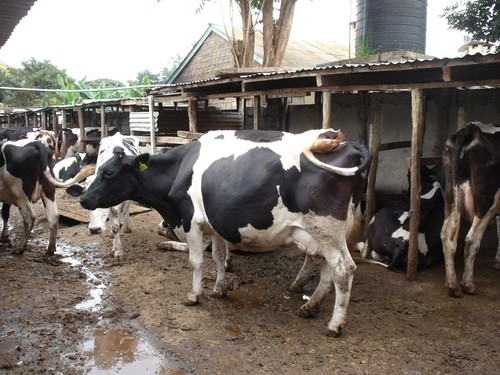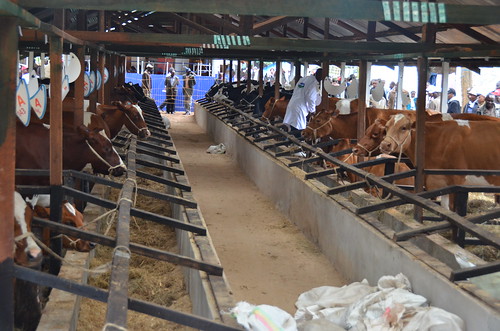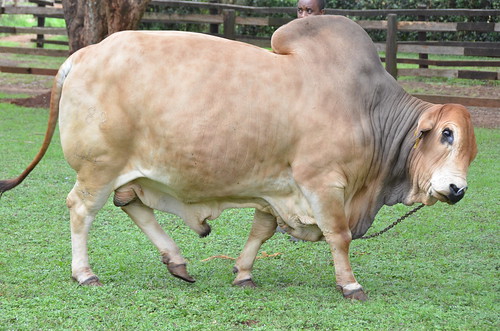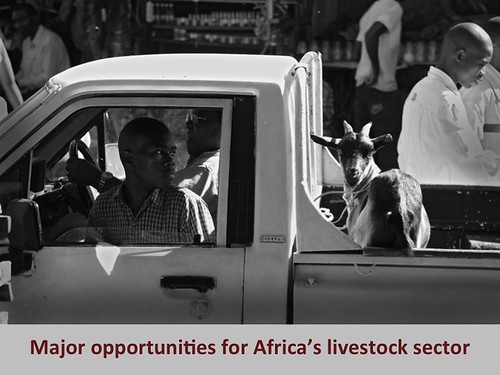Participants at last week’s (26-28 June 2013) Africa Livestock Conference and Exhibition (ALiCE2013) were offered field visits to Kenyan livestock farmers, producers and industry experts in and around Nairobi. Staff of the International Livestock Research Institute (ILRI) took this opportunity to visit a dairy farm, a livestock breeders’ show and a livestock genetics resource centre.
Tassells Farm
Dairy cows in Tassells Farm in Ruiru, near Nairobi (photo credit: ILRI/Alexandra Jorge).
One of the visits was to Tassells Farm, a dairy smallholding owned by husband and wife Kenyan farmers Moses Muturi and Susan Kasinga in Ruiru, just north of Kenya’s capital, Nairobi. Muturi and Kasinga started dairy farming, separately, when they were young, after seeing the many benefits of selling milk from other farmers who were able to take their children to good schools and live comfortably from dairy incomes.
When they married and joined their assets (16 animals), they were determined to succeed as dairy farmers and committing themselves to learning all they could about the dairy business. Today, some 16 years later, what began as a fairly small-scale dairy farm is now a thriving dairy business, with nearly 400 cows kept on five farms across Kenya. On their three-quarter-acre farm in Ruiru that ILRI visited, this couple’s visible passion for their family, their community and their dairy cows is an inspiration.
On this farm, the couple manages 70 Holstein-Friesian cows in a ‘zero-grazing’ system with the help of four farm workers. Apart from daily milking, the farm also breeds and sells high-grade dairy cattle.
‘We had little knowledge of dairy farming when we started’, says Kasinga, ‘but we gained experience by observing successful farmers, what they do and how they do it; we learned how to make the right decisions’, she says.
Their 5 farms produce about 3000 litres of milk each day.
‘On this farm, we produce 15 to 25 litres of milk per cow, about 1000 litres in total. We sell this milk to the Brookside Dairy, says Muturi, who says the following factors have been critical for their success.
Choosing and improving breeds: This is the first step towards getting cows that are well adapted to the farm environment, which guarantees high milk yields.
High-quality feeds: These should be affordable but also of good quality. The couple maintain a barn full of hay. They also grow forage and buy hay cheaply during the rainy season (sometimes by offering to cut the grass in their neighbours fields). Muturi says it’s important for dairy farmers to buy high-quality feeds and not store them for too long, which lowers their nutritional value. Their cows consume 30-32 kilos of hay each day in addition to molasses, concentrate feeds and mineral supplements. It’s crucial also, he says, to have an adequate supply of water and to collect grasses from areas free of parasites.
Managing diseases: This includes ensuring appropriate veterinary support and learning about animal diseases (they have lost 40 cows to foot-and-mouth disease). The farm now has in place a strict and regular de-worming regime, which, they say, seems to control 70% of diseases. Access to the farm is also restricted to prevent contamination.
Capacity development: Ensuring farm workers are educated about animal management and farm operations has also been key to their success. Workers from other farms now regularly visit their farm to learn with and from them.
‘Taking advantage of economies of scale is very important in the dairy business’, says Muturi. He suggests a minimum of 10 cows as a starting point for small-scale dairy farmers who want to move into wider-scale milk production and sales. ‘The more animals a farmer has’, he says, ‘the better their chance of negotiating better prices for feeds and veterinary services, increasing their profit margins.’
In future, the couple hopes to expand their business through some ‘added value’ ventures and to join like-minded farmers in setting up a milk processing facility.
Kenya Livestock Breeders Show & Sale
Dairy cows at the Kenya Livestock Breeders Show & Sale (photo credit: ILRI/Paul Karaimu).
Held 26-28 Jun 2013 at Nairobi’s Jamhuri Park, the Kenya Livestock Breeders Show & Sale is an annual event in Kenya’s livestock sector calendar that brings together livestock breeders and industry players from across the country to exchange information in seminars, presentations and demonstrations. The event also doubles as an animal auction. This year’s exhibits included breeds from well-known ranches in Kenya, such as Ol Pejeta and Solio, north of Mt Kenya, and an association of goat breeders from Meru, east of the mountain.
Kenya Animal Genetic Resources Centre
One of the bulls at the Kenya Animal Genetic Resources Centre (photo credit: ILRI/Paul Karaimu)
The Kenya Animal Genetic Resources Centre is located on a 200-acre piece of land in Nairobi’s lower Kabete area. Started in 1946 by the Kenya Government, the centre produces and distributes bull semen for use by the country’s livestock farmers. With time, the centre’s mandate has grown to include providing artificial insemination (AI) training to farmers and supplying equipment for AI services in the country.
‘We also serve as a genebank for livestock tissues, semen and DNA of all the important livestock and emerging livestock breeds in Kenya,’ said Henry Wamukuru, the centre’s CEO.
Currently, more than 120 Ayrshire, Guernsey, Holstein-Friesian, Sahiwal and Boran bulls are reared at the centre to supply semen for the country’s AI needs and for export to other countries in Africa and the Middle East. The centre works closely with Kenya’s livestock ministry and the Department of Veterinary Services to improve national herds and productivity.
About the conference
ALiCE is the largest convergence of stakeholders in the livestock sector in Africa. This is a platform specifically aimed at stimulating trade in livestock and livestock products in Africa and beyond and facilitating technology and knowledge transfer and sharing. The event brings together producers, processors and traders of livestock and livestock products and suppliers of technology, solutions and services in the entire value chain.
This post was written by Alexandra Jorge and Paul Karaimu.
Read other ILRI news stories from the ALiCE2013 conference.
Livestock present Africa with huge – ‘right now!’ – opportunities for food, prosperity, environment





